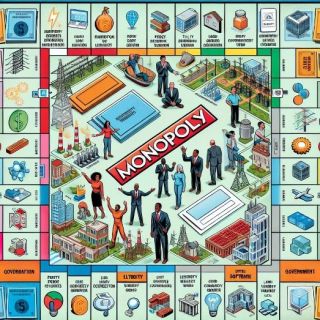The game of energy Monopoly is intricate, with strategies that have remained unchanged since before the internet era. Let’s delve into this game and understand why change occurs so slowly in the eyes of both old and new influencers.
Not too long ago, the utility industry was entirely regulated due to the necessity of installing and managing a grid that required long-term investment. As software emerged, the concept of depreciation was upheld to maintain utility and market accounting practices and policies. From the perspective of the external business world, the energy industry was neither seen nor understood. While the energy Monopoly game was being crafted and played, the primary goal was to manage an infrastructure of equipment and distribution, with consumers footing the bill for commodities and investments. Consumers had no choice but to rely on their regulated energy company for service and energy flow due to the absence of competition.
Over the past 30 years, we have witnessed only gradual changes in energy markets, primarily through the deregulation of electric and natural gas supply. This prolonged process is partly due to the regulatory landscape failing to keep up with the opportunity to change. Today the energy Monopoly game board is evolving faster than regulators and policymakers can handle. Just look at the many green buyers that are building their own generation. These massive load centers, such as data centers, represent new game board squares that alter the very nature of the game.
The “local utility,” known as the distribution provider, continues to own the wires and pipelines. As energy data flow began within the utilities, it was solely viewed as a means to manage and charge the energy consumer. This short-sighted perspective on data management persists today, leading regulated organizations to assume the role of data custodians to manage their “cash register.” We have seen that the freedom of supply “choice” has slightly shifted the energy Monopoly game boards, but due to the lack of external forces, data portability, innovation transition, and competition have been minimized and stifled by legacy influencers of the game board.
Today, in many regions of North America and the world, consumers can produce and consume their own electricity using their own assets like solar panels and other distributed energy resources (DERs). This “consumer revolution” is not restricted, yet it is evident that this revolution of independence is being hindered by data access and technology interoperability roadblocks. It doesn’t help that regulators and policymakers support these roadblocks due to their lack of expertise within their own walls, as they continue to enforce strict market roles, guidelines, and financial penalties to “protect network stability,” thereby influencing the use of legacy technology providers to manage the game of Monopoly.
Legacy influencers in the energy Monopoly game ensure the energy community still manages asset depreciation, even for software solutions, by paying large sums to vendors and gradually recouping the money over 20+ years. The vendors themselves restrict data interoperability to sustain their customer base indefinitely.
An uncontrollable change is underway. Due to localized energy-intensive technologies like AI and cloud technology, influential and deep-pocketed businesses are making their move. Data center owners and other “green buyers” aim to reduce their carbon footprint and energy dependency on utilities by modernizing their own energy infrastructure to manage risk and better control operational costs. Large entities, such as Google and Microsoft, are now proposing to operate their own nuclear-powered generators by resurrecting shuttered nuclear plants, such as Three Mile Island.
The question is how these changes will impact the average consumer and their utility bills. Will costs go up or down? Some parties have claimed that these large load centers are changing the amount of operating and contingency reserves. What can the legacy Monopoly influencers do to protect themselves, and what can they do to maintain or improve reliability and resilience?
The Power of Influencers in Today’s Society
In today’s social network industry, user experience, entertainment and network management are becoming increasingly multifaceted due to new technologies like AI and the global popularity of social interaction. Every week, social influencers leverage new tech to gain more readership as they battle to manage their influence, which in turn generates income. The energy industry cannot control the energy monopoly board when 5.5 billion+ users spend about 2.5 hours a day entertaining themselves. The historical control over the grid that legacy influencers have had can no longer be supported by government control. Social technology requires more energy, and the existing energy monopoly game players/influencers cannot sustain a rapidly changing environment that innovates and grows daily.
In the energy sector, utilities have historically shared power with others playing the same energy monopoly game, with little influence from outsiders and the understanding that assets have a long lifespan. They have no influence over consumer assets, like cell phones, which advance several times a month and are discarded after 2 to 5 years due to obsolescence. New technology requires more energy.
Looking back at the energy monopoly board, natural gas and water utilities are regulated by government policies, legacy vendors, production, storage, and distribution. Today, regulation is still influenced by formal public engagement and years of strategizing, creating a long-lasting and time-consuming relationship between energy infrastructure influencers and existing players. Most of these relationships are financially supported by regulation, old-school accounting measures, and ever-increasing rates.
In today’s game of Monopoly, politics are canceling projects that took over 10 years to get going, such as offshore wind farms. What will fill the void of these missing megawatts? Fossil fuels seem to be the only viable option, considering that these facilities can be built or recommissioned and have the capacity to meet new demands. This is a huge risk and its going back to the reality of the old guild.
If anyone else wants to play the game of energy monopoly, they must pay their own way while finding ways to gain trust from those who influence the existing status quo. In the Monopoly world, it’s like everyone already playing gets $200 to pass Go and lands on Free Parking every time they go around the board. All new players face restrictions on passing Go and Free Parking, as there is nothing free.
Electricity operates with more influencers and unique market settings but shares the same traits as other commodities because they deal with the same legacy influencers. Changes in the electricity industry are usually driven by external influences like regional politics that require quick action, but the players rarely attempt to change the game board or the rules. Tariffs, for example, are establishing a new unknown, as they are not fully understood, which adds a new parameter to the Monopoly game. It’s hard to hide increases in cost, and it’s even harder to accommodate these new charges without changing the Monopoly game itself.
The reality is that legacy energy influencers ensure slow change and repeating the past, protecting revenues, the status quo, and monopolistic traits. Systems remain the same, controlled by a “guild” of traditions and relationships that avoid outside competitors. The assumption is that if control is lost, the guild will fail, and everyone playing the game will look bad because these relationships have been intertwined for over 40 years.
The Electricity Market is set to Grow
Electricity utilities operate within unique market territories where operators manage generation and control the grid, ensuring a balance that allows the game to continue indefinitely. This oversight restricts market movement and innovation because there is no competitive nature when dealing with assets that have a long depreciation.
New players are often penalized by regulators and energy policymakers because they lack guild protection, and the guild has the government’s ear. Outsiders can’t afford to wait years for regulatory changes that may never happen. The outside world operates on short-term opportunities, adapting quickly to changes, while the guild keeps making unique adjustments that make it too costly for outsiders to influence real change. It’s like asking the new kid on the street to play Monopoly but making them wait until someone loses first. Even if they are lucky enough to join the game, they are eventually forced out by the guild because new players can never gain property on the Monopoly board. They just keep moving around the board, paying rent until they quietly leave.
There is light—or perhaps darkness—coming soon, depending on the influencers you choose to believe. Challenges facing empowered consumers and utilities include producing resilient, safe power amidst changing climates and cyber threats. The game of energy monopoly is becoming digital and resilient to the guild. Climate change and cyber threats are real. Helping utilities become more flexible and adaptable to rapid adjustments will remove the legacy business inaction that the guild was fashioned for.
The game of energy monopoly now has an unpredictable nature of market challenges and technological advancements that can’t be stopped. There are new market issues, such as those in Spain and Portugal in 2025, that appear to blame DERs for blackouts. Analysis of the root cause must still be done, but if there was more data flow between the market players, it is quite possible that these issues could be resolved by allowing everyone to work together, sharing ‘source of truth’ data in real time. However, the guild is not structured to manage these ad hoc environmental conditions we are seeing today, and they are the only ones to blame because they have ignored what is happening around them.
Market Influencers in the Energy Monopoly
Let’s be transparent: monopolies in the energy industry have become evident in recent years, with influencers blocking potential change to protect the “old boys club.” Market influencers operate within the “utility” market infrastructure (generation, transmission, and distribution), controlled by government regulation or ownership, and they are all part of the guild. Utilities create affiliates as needed to keep others out and strengthen legacy partnerships, making it almost impossible to play without being an existing monopoly board player. Despite innovative opportunities, non-competitive instruments ensure no expanded set of market players. Every game has its house rules, adapting slightly but never starting a new game quickly. It’s like the movie Groundhog Day—the more it’s played, the smarter the players get.
The technology industry is rapidly changing, and the guild is at risk because the true advantages of data sharing can no longer be suppressed. By understanding the evolving dynamics in the outside world, we can better grasp why the energy industry prefers to control change, and that’s the Achilles’ heel that will be exploited.
The guild is failing, but let’s not kid ourselves—the game of energy monopoly is complex, so there are still guild game board moves to be made. The Monopoly board will eventually be shaken up so it can never be the same again, and it will be portrayed as everyone’s problem because of the guild and the spin the existing influencers present to the outside world. But let’s be clear: this transition is inevitable and should have been better managed by listening to the new parties that want to play to help us all.
New technology like AI is just starting to transform the energy industry in several significant ways, increasing efficiency, reliability, and sustainability with lower costs for information discovery. Legacy vendors just don’t have the time to protect themselves through the guild. The technologies and business strategies they use are from the time when the Monopoly game boards originally evolved. Chances of sustaining the guild and protecting their world from intruders are very low. Here are just a few examples of rapid advancement to consider:
- Strategic Decision-Making: In Monopoly, players make strategic decisions about buying properties, building houses, and managing their money. Similarly, if allowed, AI helps energy companies (including utilities) make strategic decisions by analyzing vast amounts of data to optimize operations, forecast demand, and manage resources efficiently.
- Predictive Analytics: Just as players try to predict the outcomes of their moves based on the guild’s advice, predictive analytics to forecast energy demand, equipment failures, and market trends is already available through innovators that are more flexible and cost effective than legacy providers. Adding new innovation helps companies stay ahead of potential issues and capitalize on opportunities while reducing costs.
- Resource Management: In Monopoly, managing resources (money, properties) is crucial for success. Today’s technology assists in managing energy resources by optimizing the generation, storage, and distribution of electricity through data portability and sharing. This sharing ensures a balanced and efficient energy supply, much like managing a successful portfolio of properties in the game.
- Risk Management: Players in Monopoly must navigate risks, such as landing on opponents’ properties or drawing unfavorable Chance cards. New innovation and flexible IP that can adapt as they are found help energy companies manage risks by identifying and mitigating potential cybersecurity threats, predicting equipment failures, and ensuring regulatory compliance by being able to adapt quickly to unknown risks.
- Adaptability: In Monopoly, players must adapt their strategies based on the game’s progress and opponents’ moves to protect the guild. New tech enables energy companies and energy users to adapt to changing market conditions, regulatory environments, and technological advancements, ensuring they remain competitive and resilient.
- Efficiency Improvements: Just as players aim to maximize their returns by making efficient moves together as a guild, new players in the market can help energy companies improve efficiency by optimizing energy consumption, reducing waste, and enhancing operational performance by using multiple sources of data easily.
Reality Check
The powerful “guild,” consisting of the “commanders of industry”, controls the Monopoly board. The belief in this control continuing is strong among existing board players. Dynamic forces beyond human control are impacting the very nature of the game. Extreme weather events, both local and international, are becoming commonplace, as we are even talking about adding a new category to the hurricane scale, Cat 6.
The reality is that the guild’s influence is diminishing and can no longer be controlled by the few. Electric power generation, storage, electrification delivery, and sales are no longer the sole controlling factors. The energy industry is being forced to release data that they have always considered unnecessary for others. If they don’t release the data, technology will adapt, and the guild will lose their biggest opportunity by being data agents. The energy monopoly’s grip on the game and the ability to control who creates and consumes energy and data is quickly vanishing. They can no longer guarantee protection through the guild because the rest of the world is moving one hundred times faster, and new market players are no longer controlled by half-truths and bureaucracy.
Today’s “captains of industry” see their aging employee base and dysfunctional data islands as protectors of the old guild and game board. The current reality is that consumers of electric energy are flexing their muscles and taking control of their own destiny by deciding who produces and manages their power and their energy data. They are finding ways to do this with or without the guild. They no longer believe that rising energy costs are natural and can’t be stopped.
What does AI have to offer in the next five years? It’s unknown today, but it’s not going to take five years to find out. One truism without a doubt is that AI demands more reliable and resilient electricity. Parties are competing for energy resources to manage innovation growth, but at the same time, we are looking at and continue to stop and close down “clean energy projects” just because they don’t fit with the guild’s wishes.
The New Cybersecurity Influencers
In Monopoly, Chance cards can either make or break your game. Today, the guild has to deal with cybersecurity risks in the energy industry, and it’s not easy when it takes several months to negotiate and implement a “change request” from a guild partner. As the industry becomes more connected to the internet, risks greatly increase because technology changes daily, and the guild takes months or even years to make a somewhat simple change a reality.
Other factors influencing the game board include regulations on software companies, such as the EU CRA, which many critical infrastructure operators depend on. How will these “IT regulations” impact end users in terms of cost and new features being released, which will need to undergo supply chain risk assessments in accordance with regulations? Let’s explore how some Monopoly Chance cards simulate the industry’s cybersecurity challenges today, as these Chance cards now have new meanings:
- Advance to Go (Collect $200): Represents a positive outcome, like successfully thwarting a cyberattack. Robust cybersecurity measures can prevent breaches and keep operations running smoothly. Evolving quickly to risk is the only option.
- Go to Jail. Go directly to Jail. Do not pass Go, do not collect $200: Symbolizes a severe cyber incident, like a ransomware attack, halting operations and incurring significant costs for months or years. This quickly dissolves a relationship that the old guild has protected for the last 50 years. Parties using “non-compliant” or insecure technology could be fined by regulators and may also see their cyber insurance plans canceled due to insufficient “protections” to prevent disasters.
- Bank Pays You Dividend of $50: Represents the benefits of proactive cybersecurity investments, such as reduced insurance premiums or avoided costs from potential breaches and resolving risk with effective backups.
- Go Back 3 Spaces: Signifies setbacks caused by cyber incidents, like data breaches requiring extensive recovery efforts. It can no longer be hidden or protected by the guild. Everyone knows, even the non-players. A utility company can be impacted by a breach within their supply chain that, in turn, impacts their business. It is truly an enterprise risk that expands beyond the company walls into their third-party suppliers.
- Get Out of Jail Free: Represents having a robust incident response plan that allows quick recovery from a cyber incident. It’s hard to believe that the guild has the capability to manage this on its own. Innovation needs to evolve at the rate of cyber risk and change.
Innovation and New Opportunities in Energy Monopoly
AI drives innovation in the energy industry by enabling new business models, such as peer-to-peer energy trading and virtual power plants, creating new opportunities for growth and efficiency. These models are evolving at the rate of technology itself, making the old “stickiness” of legacy systems obsolete.
Game Dynamics and AI Algorithms: The rules and dynamics of Monopoly can be complex and hidden, much like the algorithms used in AI. Both require a deep understanding of the system to make optimal decisions. This dilemma raises the question, “Will regulations and regulators be able to control stability as these fast-moving forcing factors continue to flex their muscles?” AI algorithms analyze data and learn from it, much like players learn from their experiences in the game to improve strategies as new data becomes available. This allows new players to work together, and when an innovation is available, the old can easily be replaced with little cost to implement.
Chance and Uncertainty: In Monopoly, Chance cards introduce an element of unpredictability. Similarly, new technology like AI helps manage uncertainties in the energy industry, such as fluctuating demand, weather conditions affecting renewable energy, and unexpected cyber threats. AI can provide tools to anticipate and mitigate these uncertainties, ensuring smoother operations while adapting to regional/system changes.
By linking energy-related AI to the game of Monopoly, we can see how AI’s strategic, predictive, and adaptive capabilities can transform the energy industry, making it more efficient, resilient, and innovative.
The advancement of digital technologies that empower our smartphones and, in turn, our interests has its own influencers. The data that accompanies this activity will become more open because we are in the age of change. The dynamics of AI and innovation are being recognized by all.
Let’s be clear: some of the challenges facing these “empowered consumers” are the same that utility companies will face in the next few years. The game of Monopoly is becoming digital and resilient to the guild. One major differentiator between the real energy world and the game of Monopoly is that the game doesn’t have crooks, wars, and diseases that can impact the real world. These are also forcing factors affecting the energy game.
Climate change is affecting us all, and cyber threats are not a fantasy like the game of Monopoly. “Go to Jail” is real. Helping us all advance to “Go” helps the utility be more flexible and removes legacy business inaction. Free parking every time you move around the game board costs the ratepayer money, and the Community Chest, which will be explored at a later date, represents shared resources and collaborative efforts in the industry and the world to survive. The game of change in the game of energy monopoly is starting to highlight the unpredictable nature of market changes and technological advancements.
By understanding these dynamics and the new influencers, we will better grasp why the energy industry must evolve quickly. Business disruptors are changing the game, and it can’t be stopped. Influencers of today can help navigate this evolving landscape and still be an integral part of the future. Stay tuned for part 3 of 4.
This Article was co-written by Gary Michor and Dick Brooks. Both individuals have 30+ years of experience playing the energy game of Monopoly and watching it supress change and innovation. To see the first Article 1-4 please go here.










